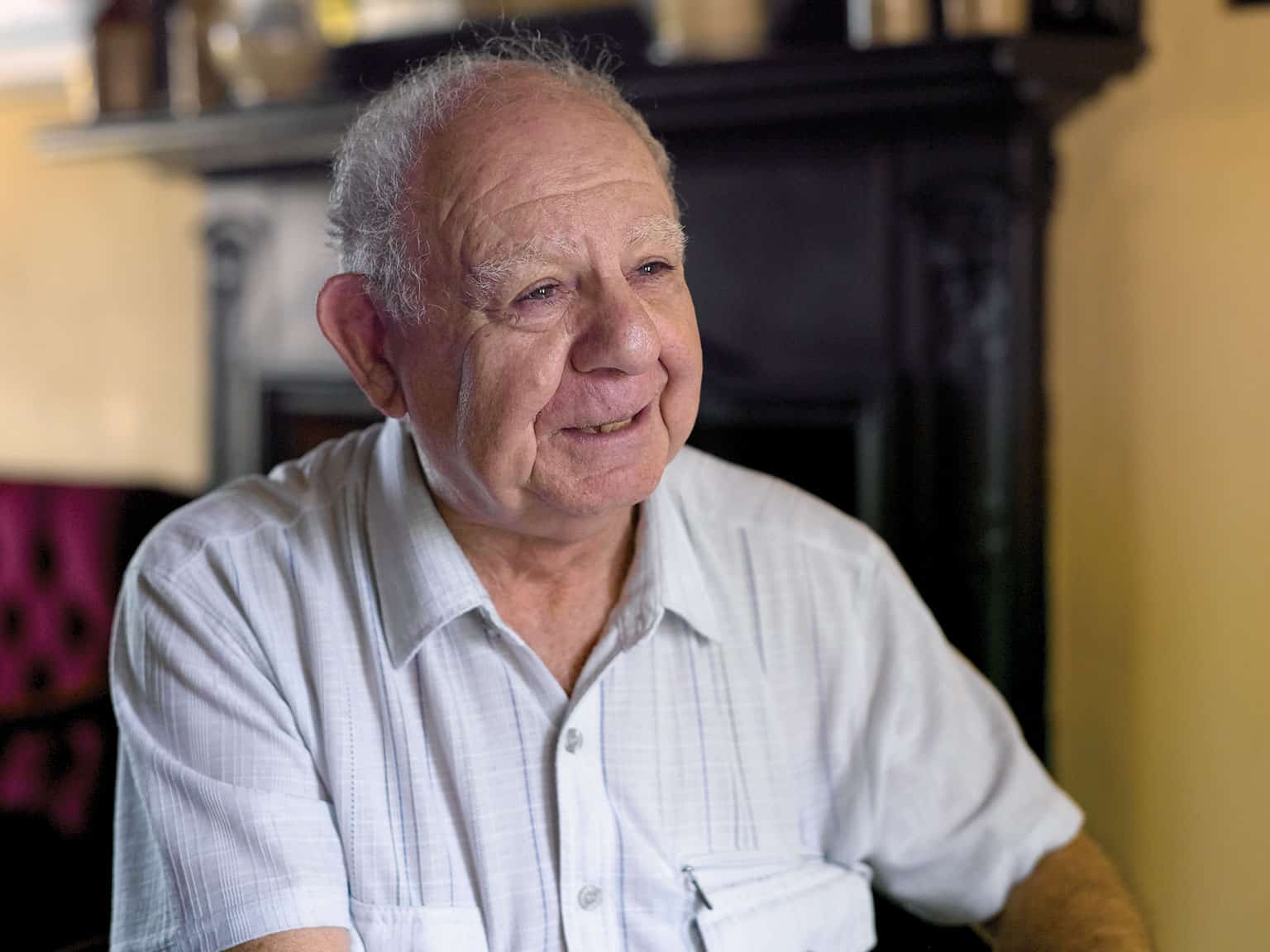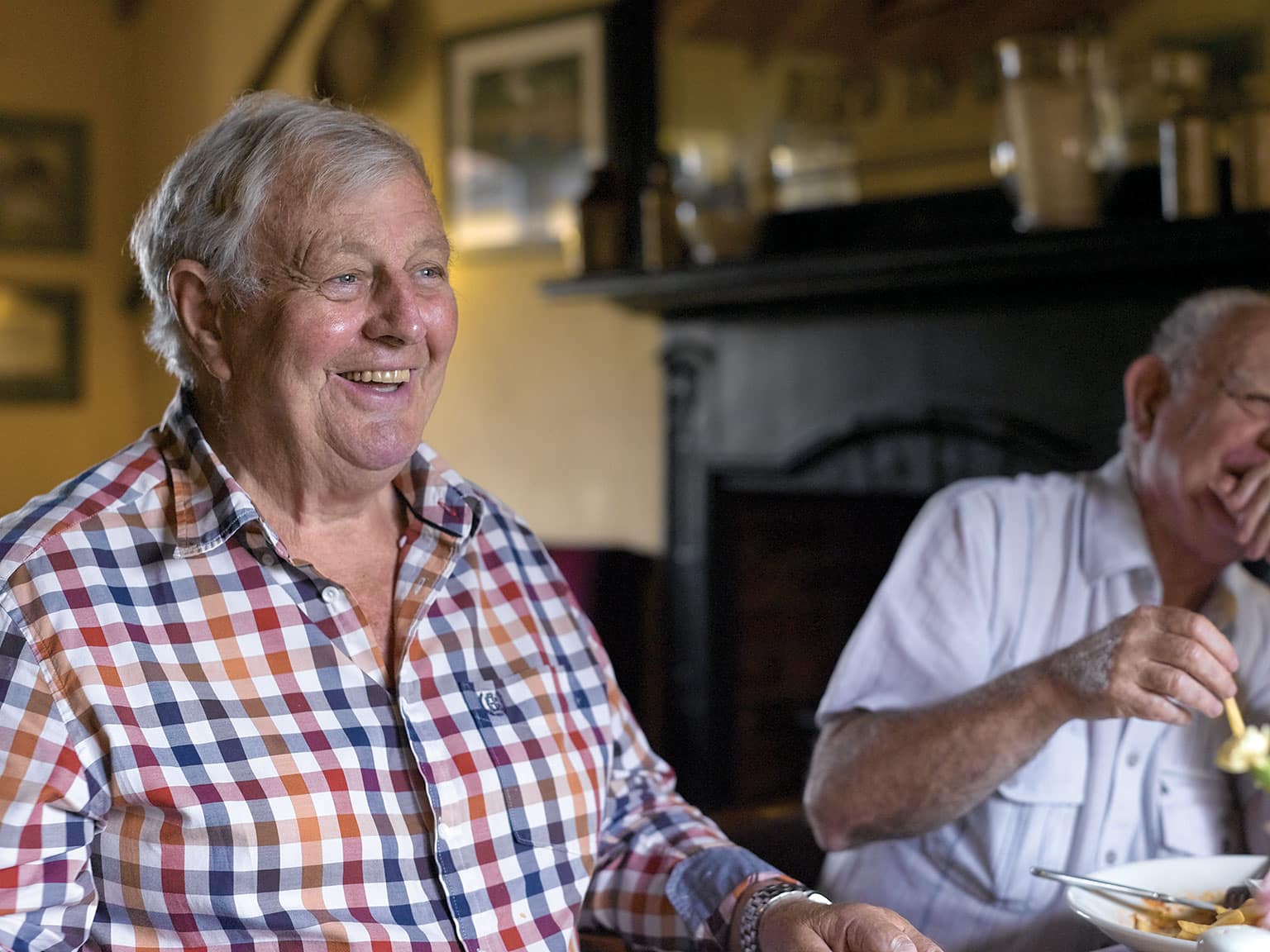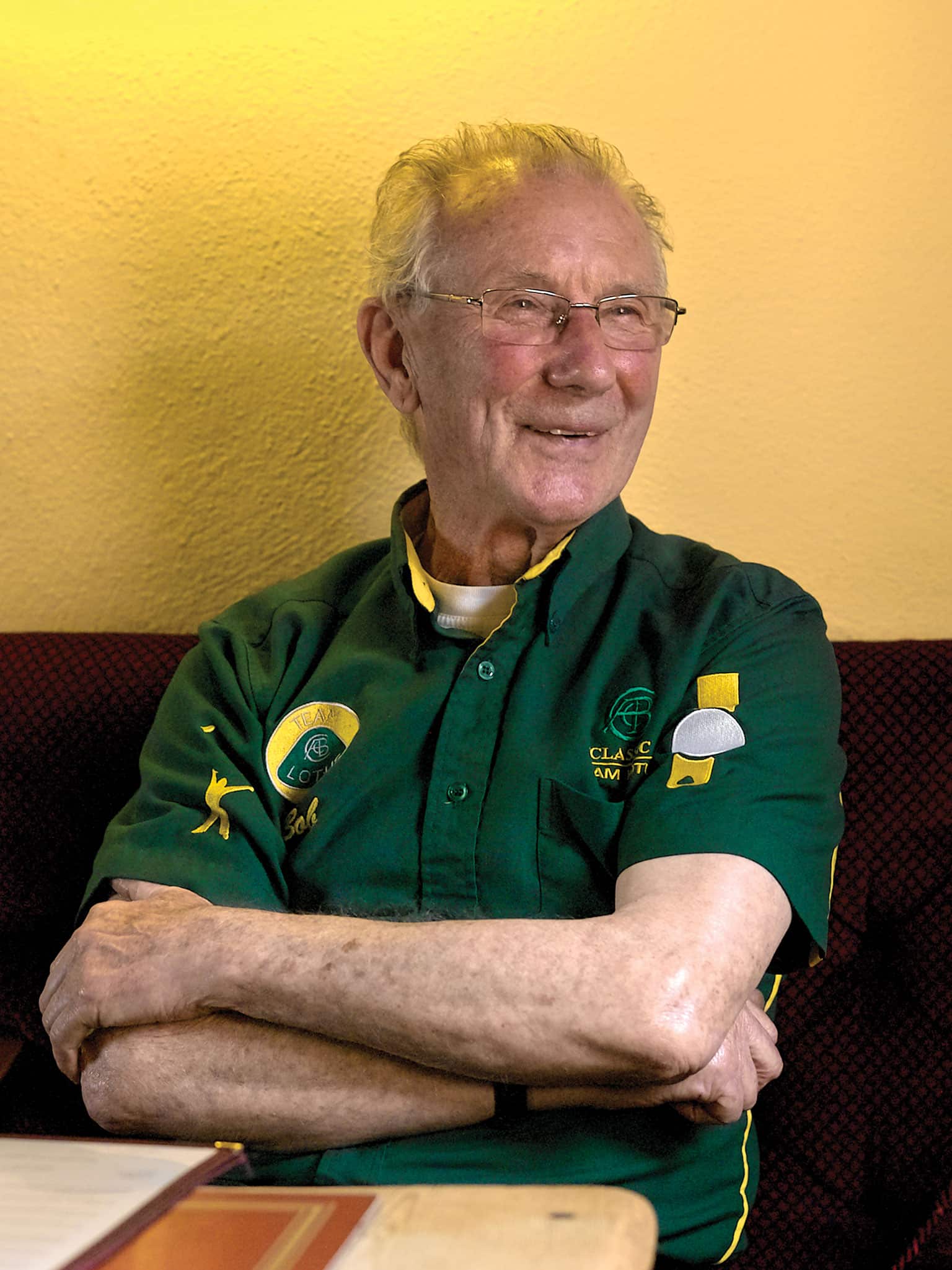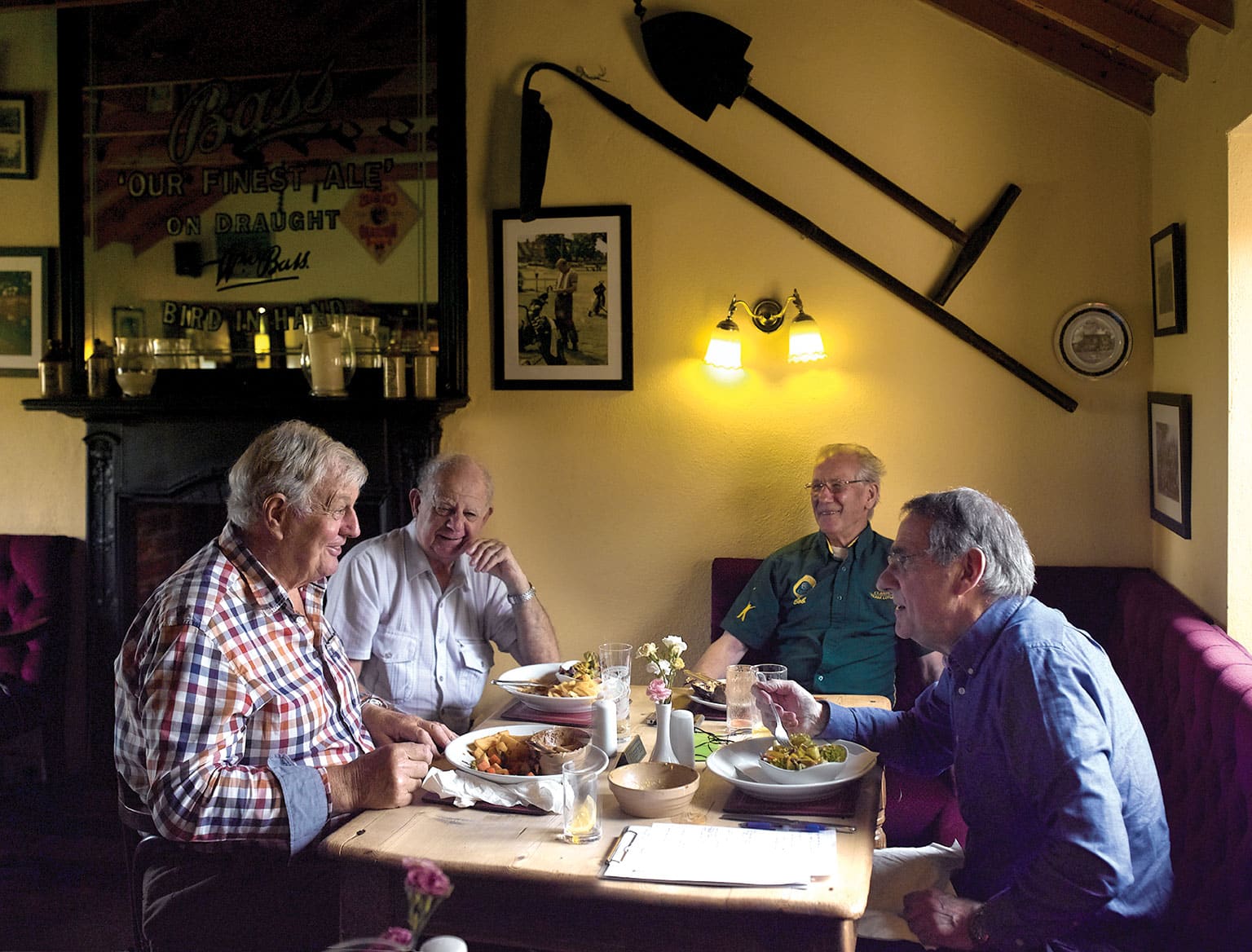Lunch with... Team Lotus mechanics
The realities of a working life with Colin Chapman and Team Lotus, as related by David Lazenby, Bob Dance and Cedric Selzer
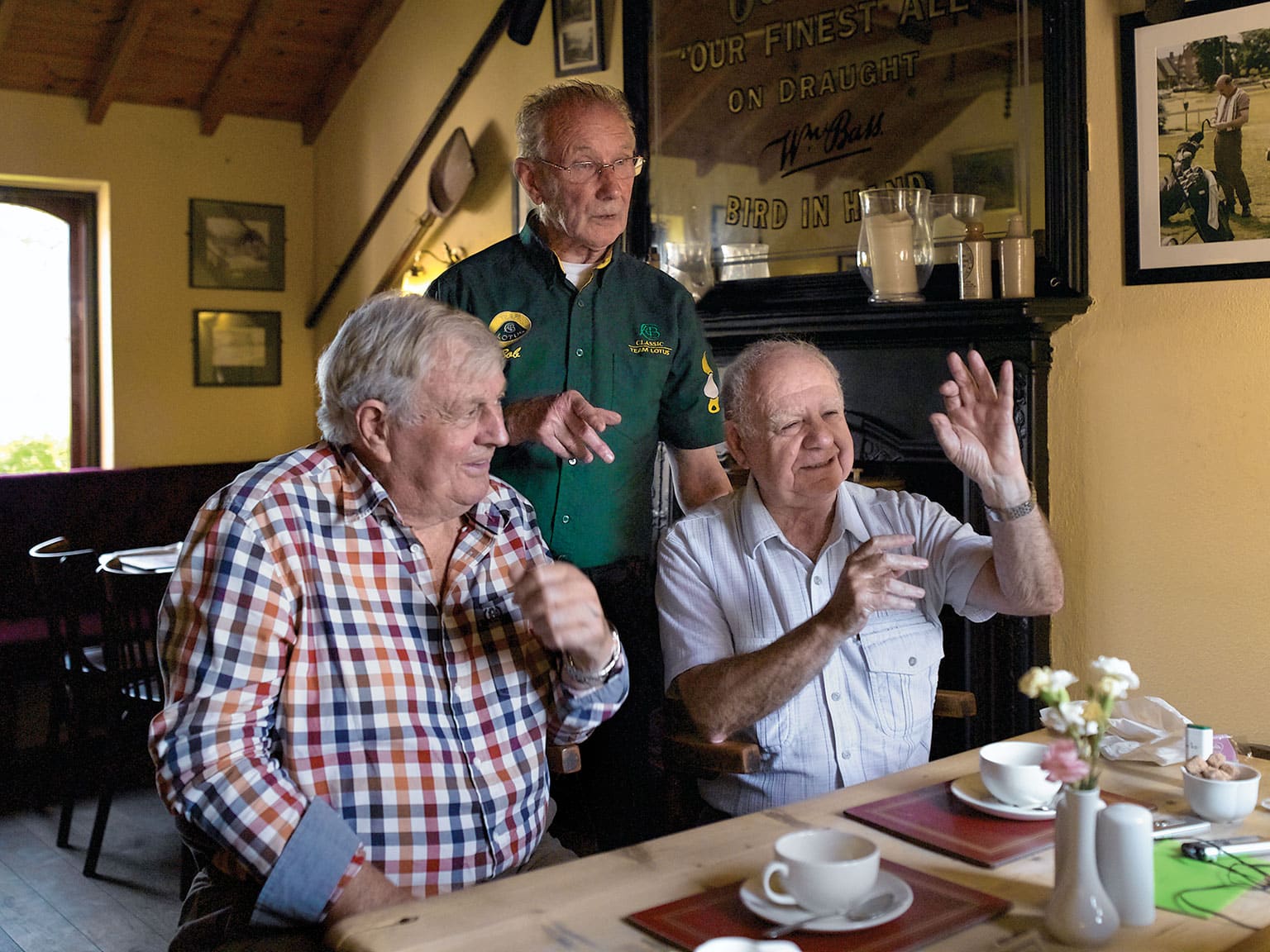
A part from the name, Formula 1 today and Formula 1 of half a century ago have very little in common. The whole massive commercialised circus exists on a stratospherically different level in the 2010s to how it was in the 1960s, and about the only similarities between the Lotus-Mercedes E23 and the Lotus-Climax 18 are that they both have four wheels and one driver.
For example, McLaren-Honda send to each Grand Prix – not counting the two drivers and their own management – 121 people. F1 rules set a limit of 45 on those who can actually work on the cars, which in McLaren’s case breaks down as 29 mechanics and 16 engineers. But there are also doctors and physios, media and marketing staff, hospitality hostesses and chefs, and no fewer than 26 truckies to get those vast pantechnicons in and out. That’s all to run two cars in one race.
In 1960, when Team Lotus fielded two cars at a continental Grand Prix, they sent just three people, or at the most four. They trundled across Europe squashed into the cab of a dodgy flat-bed Ford Transit that carried one car and towed the other on an open two-wheeled trailer. Once there they’d unload the cars, prepare them, run them through practice, carry out the drivers’ requested set-up changes, and repair any Friday and Saturday mechanical failures or accident damage. Then the race, coping with signal boards, pitstops and mid-race disasters, before loading up the remains for the drive back – trying not to fall asleep on the way, for they would have had virtually no sleep for three days.
Inevitably these men were very resourceful characters. Along with considerable mechanical and fabricating skills they had to be resilient, thick-skinned, able to work prodigiously long hours without complaint, and used to raising two fingers to officialdom. They also needed an indomitable sense of humour in the face of endless pressures, unforeseen setbacks, deep disappointments and, sometimes, tragedy. Many joined full of excitement and optimism, only to leave as the rigours of the job wore them down. For a handful of others it became the only life they knew.
Which is why I find myself enjoying a pub lunch with three men who have lived that life, and been an integral part of some of motor racing’s greatest days. The chosen hostelry is the Bird in Hand in the Norfolk village of Wreningham, just up the road from the traditional home of Team Lotus.
Bob Dance joined Team Lotus in 1960, when its F1 drivers were Innes Ireland and, in his first Grand Prix season, the young Jimmy Clark. Incredibly, 55 years on, he is still with Team Lotus – Classic Team Lotus as it is now, still at Hethel and with Colin Chapman’s son Clive at the helm. When I arrive to take Bob to the pub he is appropriately working on Lotus 25 chassis R4, the very car with which Clark won the 1963 world championship, and now raced by proud owner John Bowers. Yesterday Bob celebrated his 80th birthday: a surprise party was laid on, and to his astonishment more than 100 old motor racing friends and colleagues turned up.
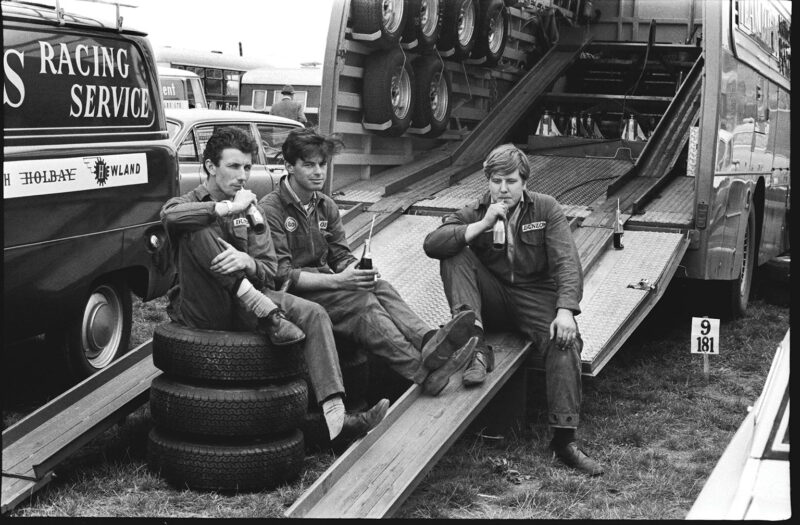
Thirsty work: Future Tui designer Allan McCall perched between Bobs Dance and (left) Sparshott
“After national service I tried to join Lotus, and they offered me three-and-six (17.5p) an hour. I was getting five bob (25p) working at a Rootes dealer, and my parents said I couldn’t take such a big salary drop. After Lotus moved from Hornsey to Cheshunt I tried again, and drove over in an Austin 7 Special I’d built. I’d made quite a nice job of it, and when Roy Babcock, who ran Lotus Components, saw it he offered me five bob an hour straight away. My first task was building the sequential gearboxes for the single-seaters, and after a few months I moved across from Components to Team.”
Cedric Selzer was Jimmy’s mechanic during his first world championship year. He came over from his native South Africa in 1961 as a racing-mad 24-year-old, and got himself to the Monaco Grand Prix. “In the Tip Top bar after the race I found the Team Lotus chief mechanic Jim Endruweit and asked him for a job. That led to a one-month trial which turned into three unforgettable years.” Cedric went on to work for Paul Hawkins and Ulf Norinder, and designed an FF100 sports-racer, the Nerus Silhouette, before settling down with his own business specialising in Mercedes road cars. In the Classic Team Lotus shop he studies R4, diminutive, slender and beautiful, and reminds us with justifiable pride: “I built that.”
David Lazenby, as a young lad, also built an Austin 7 Special. “In 1959 I was working on it in the street, and a chap walked by and said, ‘If you’ve got something like that you ought to go and work for Lotus.’ I said, ‘What’s Lotus?’ I found out where they were and went to see Len Street, who ran the Elite assembly shop, and he hired me. I got bored there pretty quickly, moved to Service, got bored there, and then Jim Endruweit suggested I join Team. After that I wasn’t bored any more, I can tell you.”
After a decade with Lotus, David left to design and build his own Hawke single-seaters, which became one of the chassis to have in Formula Ford. Then he set up a business making racing car parts. “I learned that you didn’t make money building racing cars, but you could make money selling people bits so that they could lose money building racing cars.”
Race mechanics usually gave each other nicknames: it went with working endless hours in small spaces, and being thrown together in primitive accommodation which, Cedric remembers with a grimace, once involved him and David sharing a narrow bed. David claims to have forgotten this. Cedric got his nickname as soon as he arrived: “Jim Endruweit said nobody could be called Cedric. My friends in South Africa called me Ced, but he said Sid was easier, and that soon became Sidney. David was always just Laz, and Bob became The Vicar, because he wore a white vest under his shirt which looked like a dog-collar.” He still does.
In the pub, over steak and kidney pie (Laz), baked potato with prawns (Bob) and beef lasagne (Ced) the stories pour out. It’s like three old boys meeting up at a school reunion 50 years on, remembering the dramas, the all-nighters, the make-do and mend, the pranks, and the bollockings from the headmaster.
“Colin Chapman would get into a huge paddy about nothing,” Laz remembers. “He’d come rushing through the workshop, spot something he didn’t like, tear you off a terrible strip, and storm out. He could be an absolute swine, and if you knew he was about to come through the door you’d sneak out of the other door, to get out of range. But it never lasted. Next time he came in it was all forgotten. Sometimes you had absolutely no idea what he’d been so mad about.”
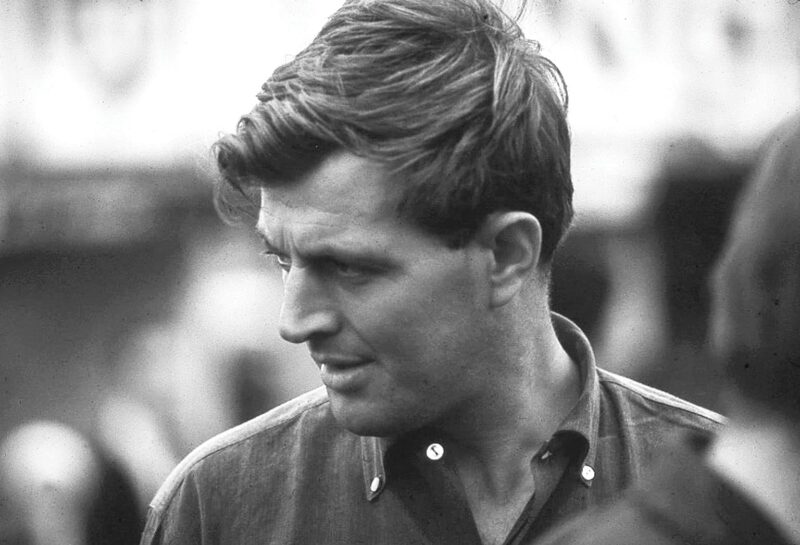
Period portrait of David Lazenby
Bob agrees: “I remember once he was in the race shop and he got so angry he was banging his head on the sliding doors, bang, bang, bang, shouting, “No, no, no, no!”
Yet for all of them Chapman was an inspiration. Bob: “He was a genius, of course. He was a hard man, but he was also a brilliant motivator. He got things out of you that you never knew you had.” Laz: “You’d have worked all night and all the next day, you’d be on your knees, and the Old Man’d come rushing in, there’d be a lot of fuss and noise, and you’d just feel picked up and you’d get on with it.”
Cedric: “If we’d had a good race weekend, if it was Sunday night and the work was finally over for a bit, we’d go out to a restaurant and let our hair down. And often the Old Man would come and join in. If there was a group from one of the other teams at another table, Colin usually threw the first bread roll. But you always had to tell the truth to the Old Man, because if you didn’t he’d always know. The only thing you lied about was the Mechanic’s Gallon.”
The famous mechanic’s gallon came from Chapman’s paranoia about saving weight: one reason why Lotuses were fast was because they were as light as possible. Bob explains: “He’d work out how much fuel we’d need for a race, and then he’d add a five per cent safety margin. But still one or other of the cars would sometimes run out before the end of the race. So we’d get the figure from Chapman, and then we’d add another gallon, just to be sure. That was the mechanic’s gallon. It used to make Colin furious: ‘We’ve spent thousands of pounds making these cars lighter, and then you slosh in more fuel and make them heavier again.’
“Later on, in 1978 when we had Mario [Andretti] and Ronnie [Peterson], I told Colin I wasn’t going to be involved in any more mechanic’s gallons. I said we had to get it right to start with. Glenn Waters and I were on Mario’s car, and Rex Hart and Nobby Clark were on Ronnie’s. At Kyalami Mario ran out of fuel two laps from the end, spluttered into the pits for a couple more gallons and dropped to seventh, and Ronnie won. Mario was livid. Glenn and I hadn’t put in a mechanic’s gallon, and of course Rex and Nobby had.”
The aforementioned Transit flat-bed was known as PMT, after its registration letters. Laz: “It was a dreadful thing. We shoe-horned a straight-six Zephyr engine into it, and you could wind it up to 80mph going downhill. Rushing along a narrow road in Northern France we lost one door mirror on a passing truck and the other on a lamp post. I went to London Airport one day to pick up a wrecked Indy chassis, and on the way back I was flat out over a brow and suddenly the steering had gone. No steering at all. It swerved into the kerb, knocked off the left front wheel and somehow ground to a halt. After that we threw it away.”
Cedric: “By then we’d also got a Bedford TK van which could take three cars, but it only had a little 2.8-litre engine, and it was absolutely gutless. It had a four-speed box and a two-speed axle, and you had to use all eight gears to keep going. If you were in the left-hand seat in Europe it was your job to shout when it was clear to overtake, but overtaking anything would commit you to the wrong side of the road for a long time. And we used to change drivers without stopping – keep your foot on the throttle while the other guy slid underneath you and grabbed the wheel.
“We were entered for the Pau Grand Prix in 1962 with two 24s. There was one for Jimmy with a V8 Climax, but we didn’t have another V8 for Trevor [Taylor]. So at the last minute Colin told us to put in a four-cylinder, and we worked three days and the two nights between to get it done, inventing and fabricating the engine mounts as we went along. At midnight on the second night Jim Endruweit suggested I got a couple of hours’ sleep in the Bedford, and he woke me at 2am to get back to work.
“The next afternoon the Bedford had to leave with the Clark car because it was booked on the ferry. Colin told Jim and Laz to get across the Channel and wait for the second car on the French side. I worked on, making up a throttle linkage, doing all the last bits, and Colin came in and said, ‘Right, time to go. Get it onto PMT, drive down to Dover, push it onto the car deck and leave PMT on the quayside. When the boat gets to France push it off the car deck, meet up with the others, load it up and off you go.’ I said to Chapman, ‘I’ve done three days and two nights straight, I’m in no state to go anywhere.’ ‘Of course you are,’ he said. ‘Come up to my office.’ And he poured me a massive tot of whisky.
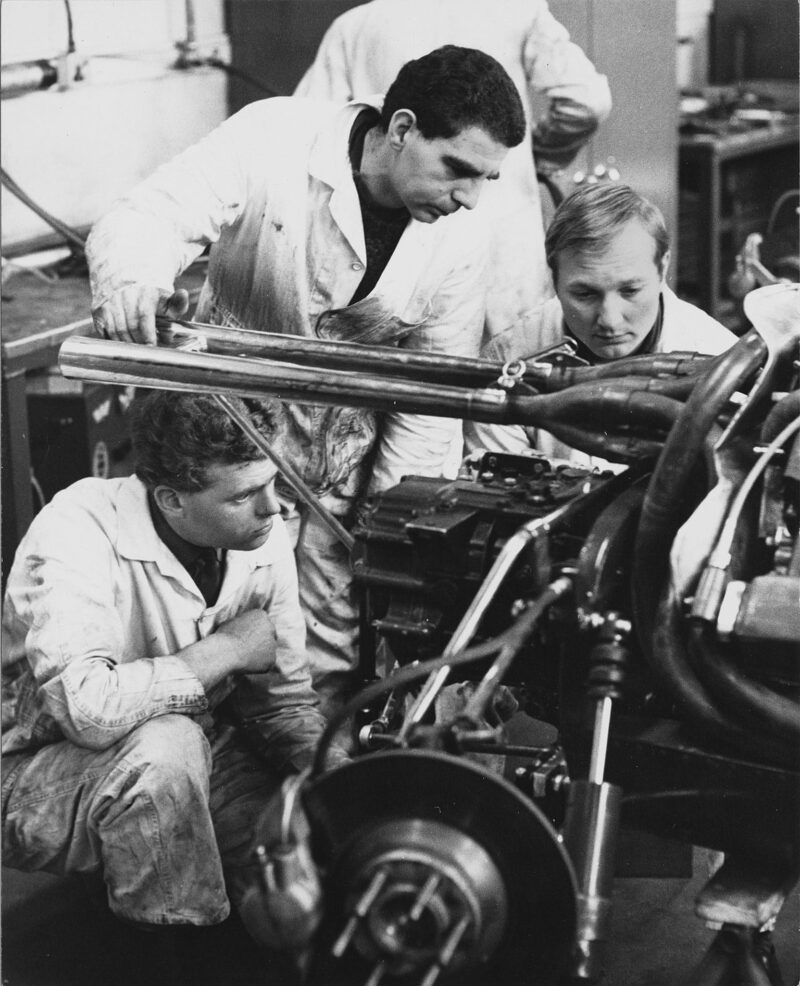
Cedric Selzer focuses on workshop preparations in 1964
Motorsport Images
“After that I felt even worse, so he phoned Pete Arundell, who was driving for us in Formula Junior then, and told him he had to drive PMT, the 24 and me to Dover. Pete was extremely grumpy about being demoted to truck driver – to be honest, he was usually pretty grumpy – but we set off for Dover. Four fitters from Components were still working on the car, and as we drove off they were hanging on the back of the truck trying to fix the bodywork. They jumped off when we got to the Red Cow pub in Waltham Cross.
“Pete drove like a lunatic, and in Walthamstow High Road we nearly mowed down an old dear on a zebra crossing, so I shut my eyes. At once I was asleep. I woke at Dover, and we pushed the 24 onto the ferry car deck, tiny beside all the trucks and cars. Pete, still grumpy, turned PMT round and shot back to Cheshunt. When I got to Calais the others were there waiting for me. We pushed the 24 into the Bedford with the Jimmy car, and we drove the 700 miles to Pau. For three days I hadn’t been home, hadn’t changed my clothes or showered. I must have smelt like a polecat.
“Of course Trevor’s car hadn’t turned a wheel, hadn’t been set up at all. We tried to sort it during practice, but in the race he had lots of pitstops to solve various problems, and our reward for all that work was him finishing last. And hotel rooms hadn’t been laid on for us: that was the time Laz and I had to share a bed.”
There are many more stories. Smuggling Derek Wilde, the team gearbox man, in and out of Holland for the Dutch Grand Prix, hidden under a car cover, because Chapman suddenly decided he should go but wouldn’t let him go home to fetch his passport. Also at Zandvoort, on a rare night off when the cars were ready for the next day’s practice, joining a group of BRM mechanics singing rude rugby songs in the street with Graham Hill conducting, and then stripping off and plunging into the freezing cold sea – with Tim Parnell the subject of much mirth because he insisted on keeping on his very large pair of underpants.
At Zeltweg, after a late night working on the cars, coming back to the hotel which was quite smart: the sort of establishment where you put your shoes outside the door to be cleaned when you went to bed. “Derek collected up all the shoes and put them outside different doors on different floors. Well, it seemed funny then.”
Then there was Bob’s bomb. In the Cheshunt car park, one of those old-fashioned stick-on demister bars disappeared from the windscreen of a colleague’s aged Rover. Then Bob saw the stolen demister on the screen of an even more ancient Ford 10 parked in the road. “I thought, we’ll fix him. So I made a bomb out of a plastic bag filled with acetylene. I sneaked it under the bonnet and connected it to the HT lead.
“We saw this old boy go to his car and there was a giant flash and a huge bang. The Ford’s bonnet came off its hinges, and its front wings fell off into the road. A crowd gathered, so we thought it was time to sneak off to the caff down the road for our tea. The police took the car away and fingerprinted it, but by the time they came back we’d gone off to the next race. If you did that now you’d be locked up for a long time, but things were different then.”
Working conditions at races weren’t always easy. The cars might be quartered in a back-street garage with an earth floor, or sometimes the paddock was just a grass field, and when it rained everything – cars, tools, mechanics – got wet. Cedric: “At Monaco we always used a little garage four miles up the coast at Eze-sur-Mer. We’d drive the cars to and from the track every day, among the camions and taxis and 2CVs. The gendarmes didn’t mind. The only worry was you were so low that people couldn’t see you, and you felt a truck might go straight over you.
“One year at Monaco we were working on the cars and we noticed a very pretty girl standing there watching us. She was English, and I think she was after Jim Clark. A lot of girls were. So I said to her, ‘While you’re hanging around you might as well make yourself useful,’ and I gave her a set of overalls and told her to clean the wheels. She got to it, and of course Chapman chose that moment to come rushing in to hand out a couple more jobs for us. He looked at her and said, ‘Who’s that?’ I explained, and he just said, ‘See she doesn’t break anything’ and rushed out again.”
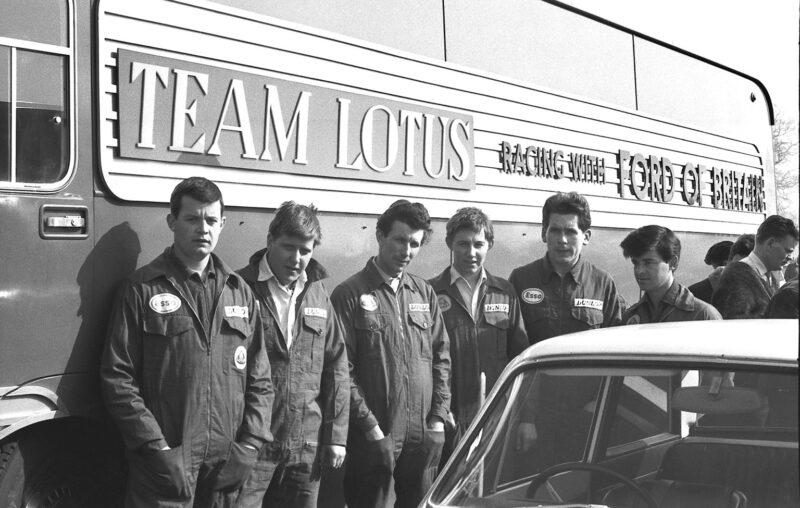
Team Lotus line-out: From left: Bob Cull, Bob Sparshott, Bob Dance, Arthur Birchall and Allan McCall
Some of the drivers appreciated how hard the lads were working, some didn’t. According to Laz, “Jimmy was a really nice guy. He was quiet and reserved, but he’d take the time to come and look at what we were doing. He was always interested. At first he was just this rural sheep farmer parachuted into F1 from the Scottish borders. Within a few years he was much more sophisticated, living in Paris while his tax situation was sorted out, with lots of beautiful girlfriends.”
They all agree that the bond between Chapman and Clark was very strong. Says Cedric, “I only once remember Colin losing his rag with Jimmy. It was that 1962 Silverstone International Trophy when Graham Hill caught Jimmy napping and they crossed the finish line side by side, with the BRM’s nose just ahead. Jimmy said he’d seen the pit signals showing him the gap to Hill, but he didn’t register them properly. It was a most unusual mistake for him. Back in the paddock Colin showed his displeasure in a typically Chapman way. The public were allowed into the paddock in those days, of course, and with everybody milling around The Old Man shouted at Jimmy: ‘You’ve let the mechanics down. You’ve let the team down.’ It was very embarrassing. I just went away and hid until it was over.
“But the thing about Jimmy, one of the ways he was so much better than everybody else, is that if there was a problem with the car he just drove round it. Like in the 1963 French Grand Prix at Reims: he got a bad misfire, the engine was at least 1500rpm down, but he managed somehow to stay in front. Then it started to rain, and as the track got slippery he even extended his lead, and he won.”
Bob: “Another one was the 1965 British Grand Prix. He was in the lead, Hill’s BRM was second, and suddenly Jimmy was coming through Woodcote every lap with his engine apparently dead. Then on the straight the engine would cut in, sounding fine and healthy. We couldn’t understand what was going on. Because of this Hill was catching him, but Jimmy managed to stay ahead and won by 3.2sec. Afterwards he told us that on long fast right-handers, like Woodcote, the oil pressure needle was sagging down to zero. He didn’t want to run the bearings, so on those corners he was dipping the clutch and coasting round. And like that he got to the flag.”
Cedric has another story that underlines Clark’s natural talent. “At the 1964 French Grand Prix at Rouen there was a support race for historic cars, and Patrick Lindsay won it from pole with his ERA, Remus. He’d raced it for years, it was totally familiar to him, and he was very quick in it. Jimmy asked Patrick if he could try it. Rouen was a really challenging road circuit, particularly those fast downhill sweeps, and Jimmy had never driven anything like that. It was totally alien to his experience, sticking up in the cockpit with that big steering wheel and rock-hard suspension. He only did four laps – but at once he got several seconds under Lindsay’s pole time. Afterwards I asked him what it was like: ‘It handles quite well, actually. But it’s a bit bumpy.’
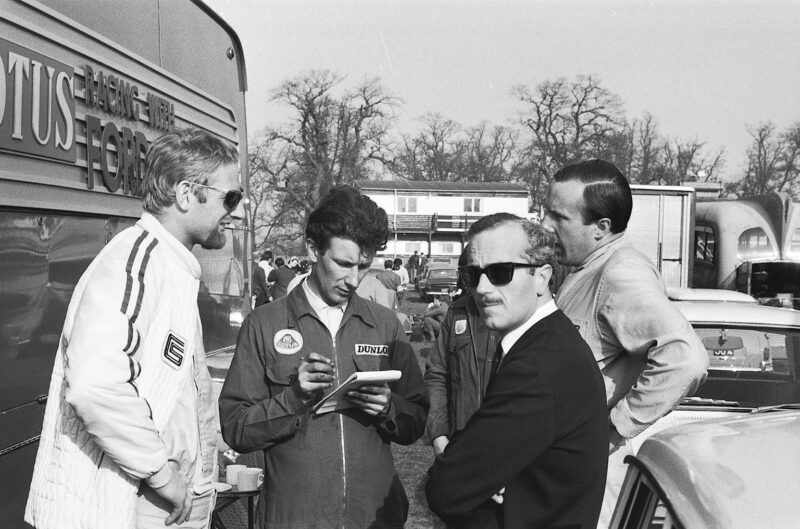
Dance takes notes as John Whitmore and Jack Sears discuss matters cortina at Oulton Park, while Colin Chapman dreams up the next great idea
“And remember Spa in 1963? He had a lead of more than two minutes at two-thirds distance, and then the rain came and it really bucketed down. He won by nearly five minutes.
“But he could get uptight. Out of the car he used to bite his nails a lot. And if something scary happened to him his eyes would go big. At Pau once Ferodo gave us some new brake pads to try in practice, DA2s instead of DS11s. They weren’t right, and Jimmy nearly had a very big accident. When he came back his eyes were open very wide.”
Laz remembers that black day at Monza in 1961. “At the end of the second lap Jimmy didn’t come round. We ran down to the Parabolica, and arrived at this dreadful scene. ‘Taffy’ von Trips’ Ferrari and Jimmy’s Lotus had collided, and the Ferrari had gone through the wire fence. We could see spectators dead and dying. Taffy was dead, but Jimmy wasn’t hurt. He was completely shattered by what had happened, and Colin got him flown out of the country at once before the authorities could get to him. They impounded his car, and they didn’t release it until years later.” Two years passed before an Italian court finally decided that Clark was blameless.
Of course Bob remembers April 7 1968. “Jim Endruweit and ‘Beaky’ Sims were at Hockenheim running Jimmy and Graham in the F2 48s. I was at Brands Hatch for the BOAC 500, running the 47 for Jackie Oliver and John Miles. That’s where I heard the news. It was a left rear puncture that killed Jimmy, absolutely no doubt about that. When the car came back the Old Man got together a group to examine it properly: Keith Duckworth, Mike Costin, an air-crash investigator and me. And that’s what it was. Somebody’s clutch had exploded a lap or so earlier, and Jimmy probably picked up a bit of debris. The tyre must have been deflating as he went into the curve, and under cornering forces it went down into the wheel well.”
[Some months later Chapman told me, off the record, that they knew a puncture had caused Clark’s fatal accident, but he decided not to make that fact public. He said: “We had a good commercial relationship with Firestone. It would have made terrible publicity for them, even though the puncture almost certainly had an external cause. And it wouldn’t have brought Jimmy back.”]
Bob again: “For Colin, Jimmy’s death was a crushing blow. The first European Grand Prix of the season was in Spain five weeks later. Colin sent just one car for Graham, but he stayed at home. Driving the transporter down, we got to the Spanish border to hear that Mike Spence had been killed at Indianapolis testing one of the Lotus 56 turbines. I remember thinking, ‘Oh no. Surely the Old Man will pack up now.’ Well, Graham won that race. And Graham went on to be world champion that year.
“Jimmy got his results by pure natural talent; Graham got his by hard graft. He was a very strong character, wanted everything to be as he liked it to be. He wrote everything down in a little notebook. When we were setting up a car he’d get out his book and say, ‘Let’s see what we did here last year’ – even if it was a different car.”
Of the other drivers, Cedric remembers Trevor Taylor as being particularly friendly. “By the time he joined the F1 team the Chapman/Clark relationship had become very strong, and Trevor felt rather excluded, a bit of an outsider. So he used to spend a lot of time with us. Trevor was seriously quick. He had some big accidents, but usually they weren’t down to him. One was at Spa when Willy Mairesse nudged him from behind, caught the linkage at the back of the gearbox and pushed it into neutral. Trevor spun, they collided, the Ferrari turned over and caught fire. The next year, also at Spa, on a fast part of the track he went straight through a marshal’s post, completely demolished it.” The history books say the cause of that one was a puncture. “No, what happened was a bolt came loose in the rear suspension and it fell apart. I won’t tell you the name of the mechanic responsible, but he didn’t last long. He was what we used to call a big hammer man. Trevor had a serious one at Enna, too. The car turned over and over down a steep bank, but he fell out onto the track and was only bruised.”
Bob: “Pete Arundell came after Trevor, and he wasn’t so easy to get on with. He believed he was as good as Jimmy. He wasn’t, but he was certainly very fast, until he had that Formula 2 accident at Reims. He spun, Ritchie Ginther’s Lola hit him amidships, and he was thrown out and badly injured. He took a long time to come back, and he was never as quick after that.”
Some drivers treated mechanics as equals. Cedric: “At the Nürburgring one year a gang of us went into the Sporthotel and Phil Hill was there chatting to Ginther. I said to Phil, ‘What about taking us round?’ We all squashed into his little Alfa 1600 and he took us round the ’Ring on the limit, as fast as it would go with five people on board. He knew every bump and every marker: ‘The car’s going to jump to the left here – there used to be a hut there, but they’ve moved it – this is a blind right followed by an uphill left – that’s where [Onofre] Marimon was killed.’ He knew every inch of that place. I don’t reckon one of today’s F1 superstars would trouble to take a gang of mechanics round like that.”
Laz was very much involved in the Lotus effort at Indianapolis. “After Watkins Glen in 1962 we took Jimmy’s little 1500cc F1 car to Indy so he could do some test laps. He just flew round, and all the locals were a bit goggle-eyed to see this fiddly little car with its miserable little engine go so quick. The year before Jack Brabham raced there with a 2.7 Cooper and finished ninth. So the Limeys had arrived, and before long the Yanks had to throw away their front-engined roadsters.
“The first year, 1963, we had Jimmy and Dan Gurney. They ran one-two at one point, and in the end Jimmy finished second. Dan is a fine, lovely man. He was very picky, always changing this, changing that, but you couldn’t fail to get on with him. For 1964 we had Ford’s four-cam engine. Jimmy got pole and led the race until the rear suspension collapsed because the tyres fell to pieces, and we pulled Dan in before the same thing happened to him. At our third attempt, 1965, we won.
“The Indy establishment didn’t know what to make of us Brits. One year we’re working away really late, finally get it all back together, and we decide we’d better see if it’s all working. So we fire it up, open the gates, and I drive it around the track with Mike Underwood sitting on the engine cover with a torch making sure it’s all holding together. I do a couple of laps, get back to the garage, switch off and shut the doors. Then all hell breaks loose: lights, sirens, people banging on the door. They didn’t like us using their sacred track in the dead of night.”
Bob: “We also got seconded into Ford’s Lotus-Cortina operation. Jimmy went rallying in the 1966 RAC, and he was fastest on several stages until he rolled it. Bob Sparshott and I went to the Marlboro 12 Hours in the USA, and our three Cortinas finished first, second and ninth, with Jackie Stewart, John Whitmore and David Hobbs on the strength. After that Colin said to Bob and me, ‘You’d better go up to New Jersey and help with the Trenton USAC race.’ Parnelli Jones won that for us, then we went on to Milwaukee, where we were running Parnelli and Walt Hansgen.
“But Hansgen crashed in practice and broke his leg. There was a lot of money involved, so the Old Man said, ‘If you can get that car repaired I can get AJ Foyt to drive it.’ So we set about another night and day repair job. I never found out whether we had a hotel. But Parnelli and AJ driving for Team Lotus: what a pairing. On the ovals those cars had two gears, starting and racing. At the start AJ couldn’t get into race gear, and retired straight away. All that work for nothing. But Parnelli? He won the thing. Lots of dollars, and the Old Man paid us a share, in cash.
“The Yanks still weren’t sure about the Limeys. No girls were allowed anywhere near the cars then. Bob Sparshott had quite long hair, and Parnelli and AJ got the biggest pair of scissors and chased him around the garages. Bob was quite chunky, but he wanted to keep his hair, and he outran them.”
Colin Chapman’s sudden death came one December night in 1982, when he was just 54. Bob again: “We were at Snetterton, about to test one of the first active suspension set-ups. We’d got there bright and early and were waiting for [team manager] Peter Warr to turn up. When he arrived he pulled me to one side, looking very serious. I thought, What’s this? Is Lotus in financial trouble? And Peter said, ‘I’m sorry to have to tell you that Colin died last night.’ It was a real shock. But I remembered what Colin had said to me once: ‘Nobody is indispensable. If anything happens to me, I’d expect you all to carry on.’ So I said, ‘We’d better get on with this test’.”
Bob has certainly carried on, although he did leave Team Lotus for a spell. “When March were starting up for the 1970 season Robin Herd approached me. They’d signed great drivers: Amon, Siffert, Mario in the STP car. Lotus were going through a difficult period: the four-wheel-drive car had been a failure, and they were cutting back. So I thought, after 10 years maybe a change will do me good. I did a year with March, which was a real mixed bag, and then Herbie Blash, who’d been a Team Lotus mechanic but was now at Brabham, told me Bernie Ecclestone wanted to see me.
“Bernie was very down to earth and straightforward. He said. ‘I keep the numbers low because the more people you have, the more trouble you got.’ But he looked after the basics, he didn’t short-cut on necessary things, and he paid quite well. I was with Brabham for five years, and then Chapman told Peter Warr to get me back. And working for the Old Man second time round, he was more mellow.”
Bob is still a Team Lotus man, as he has been for so long. Cedric divides his time between London and Johannesburg: he has written a fascinating 220-page autobiography covering his time at Team Lotus, and Jimmy’s first world championship year. And David’s entrepreneurial ingenuity is still at work: he has dreamed up a new type of mandrel pipe-bender, and formed a company to make it. “It may not sound exciting, but it’s really taken off. I started off in our garden shed. Now we’re in an industrial unit, and we’re sending them all over the world.”
So the energy and resourcefulness of these three remarkable men remains undimmed. They all agree that life as an F1 mechanic has changed – and not only because there are now 10 times as many per team. Laz sums it up:
“One of the old Team Lotus guys who went on to Cosworth, Dick Scammell, was talking to a current F1 mechanic and said, ‘What do you do after the race? How do you relax, how do you socialise?’ And this guy said, ‘We go to the gym.’ What a miserable existence!
“We worked very hard, but we always seemed to be laughing. We never lost our sense of humour. Today they don’t have anything like the fun we did.”
